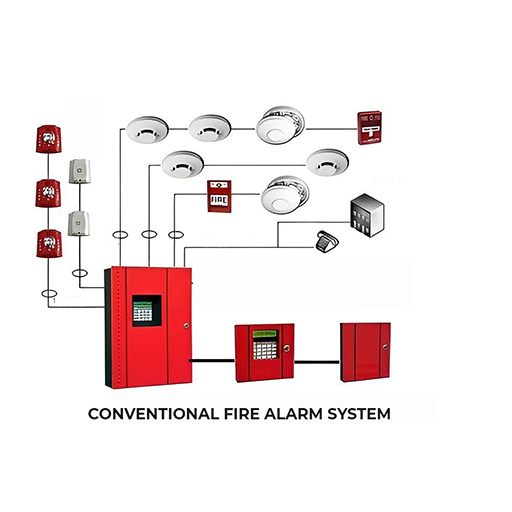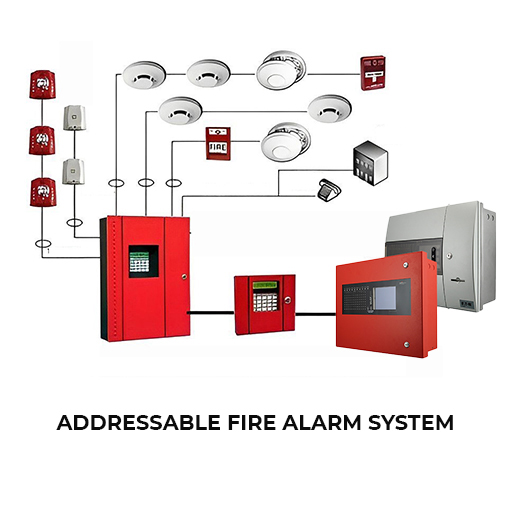Fire Alarm System
A fire alarm system is a network of interconnected devices designed to detect and alert occupants about the presence of fire, smoke, or other emergencies in a building. These systems play a critical role in enhancing life safety by providing early warning and facilitating timely evacuation. There are different types of fire alarm systems, with the two main categories being conventional and addressable.
Conventional Fire Alarm System
A Conventional Fire Alarm System is a type of fire detection and notification system used in buildings to detect and alert occupants about the presence of fire or smoke. In a conventional system, the building is divided into zones, and each zone is connected to a specific circuit on the control panel.
Detectors and other devices within a particular zone are wired together, and the control panel receives signals collectively from all devices within that zone.

Features of a Conventional Fire Alarm System:
1. Zoning: The building is divided into zones, which are often based on specific areas or floors. Each zone has its own set of detectors and devices connected to a dedicated circuit on the control panel.
2.Detectors and Devices: Smoke detectors, heat detectors, manual call points (manual pull stations), and other input devices are installed throughout the building within each zone.
3.Alerts: When a detector in a specific zone is triggered by smoke, heat, or manual activation, the control panel receives a signal indicating the affected zone. However, conventional systems do not provide information about the specific device within the zone that has been activated.
4.Indication: The control panel typically displays the activated zone, allowing building occupants and emergency responders to have a general idea of the location of the potential fire.
5.Wiring: Devices within a zone are connected in parallel, simplifying the wiring structure. Each zone is connected to the control panel by separate conductors.
6.Cost-Effective: Conventional fire alarm systems are generally more cost-effective than addressable systems, making them suitable for smaller buildings or locations with simpler layouts.
Addressable Fire Alarm System
An Addressable Fire Alarm System is a type of fire detection and notification system that provides precise information about the location of each individual device connected to the system.
In an addressable system, each fire detector, manual call point, or other input device has a unique address or identifier. This allows the control panel to identify the specific location of an activated device, providing detailed information about the area where a potential fire or emergency event is detected.

Features of a Addressable Fire Alarm System:
1.Individual Device Addressing: Each device on the system has a unique address, allowing the control panel to pinpoint the exact location of an activated device.
This feature provides detailed information about the specific room, floor, or area affected by a potential fire or emergency.
2.Early Detection and Response:
Addressable systems facilitate early detection of fire events, enabling quicker response times and potentially minimizing damage and injuries.
The ability to identify the exact location of a fire event allows for a more targeted and efficient emergency response.
3.Reduced False Alarms:
These systems can provide additional information about the type of alarm (smoke, heat, etc.), helping to reduce false alarms and allowing for better discrimination between actual emergencies and non-threatening events.
4.Remote Monitoring and Control:
Many addressable systems support remote monitoring and control capabilities.
Building management or emergency responders can access real-time information about the system status, receive alerts, and take necessary actions remotely.
5.Large and Complex Buildings:
Addressable Fire Alarm Systems are well-suited for larger and more complex buildings, such as commercial complexes, industrial facilities, hospitals, and high-rise buildings.
In such environments, the ability to precisely locate the source of a fire is crucial for effective emergency response.
6.Expandability:
Addressable systems are often more easily expandable compared to conventional systems.
New devices can be added to the system without requiring a complete overhaul, making it suitable for buildings with changing configurations or expansions.
7.Integration with Other Systems: Addressable systems can often be integrated with other building management systems, enhancing overall facility monitoring and control.
How it works?
Addressable Fire Alarm Systems work by providing individual addresses or identifiers to each fire detection device, manual call point, or other input device connected to the system. This allows the control panel to communicate with and monitor each device individually, providing precise information about the location of a potential fire or emergency event. Here is an overview of how Addressable Fire Alarm Systems work:
1.Device Addressing: Each device on the system, such as smoke detectors, heat detectors, and manual call points, is assigned a unique address or identifier. This addressing is usually done during the system’s installation and configuration.
2.Device Communication: The devices are connected to a loop or network that links them to the control panel. This loop allows the devices to communicate with the control panel and vice versa.
3.Detection and Activation: When a fire or smoke is detected by a device, or when a manual call point is activated, the device sends a signal to the control panel. This signal includes the unique address of the activated device.
4.Control Panel Response: The control panel receives the signal and uses the unique address information to identify the exact location of the activated device. This precise information is crucial for emergency response.
5.Alerts and Notifications: The control panel can trigger alarms, strobes, and other notification devices to alert occupants about the emergency. The specific devices activated are indicated, allowing occupants and emergency responders to know the exact location of the potential fire.
6.Display and User Interface: Many addressable systems feature a user interface on the control panel that displays real-time information about the status of each device. This interface may show the device addresses, their current status, and any alarms or faults.
7.Remote Monitoring and Control: Some addressable systems support remote monitoring and control. This allows building management or emergency responders to access information about the system status from a central location and take necessary actions.
8.Testing and Maintenance: Addressable systems often include features for testing and maintenance. Periodic testing of devices can be conducted, and the system can generate reports to help ensure the system’s reliability.

